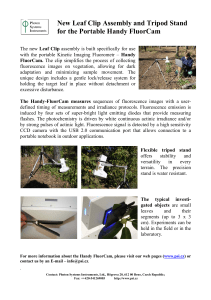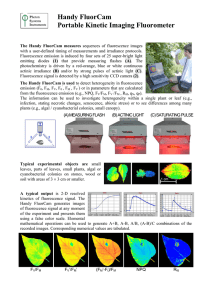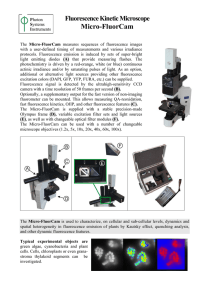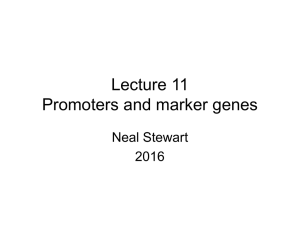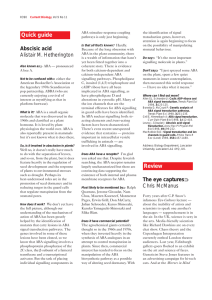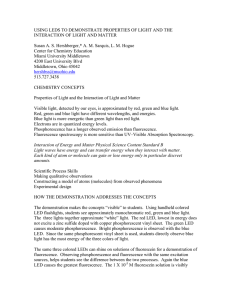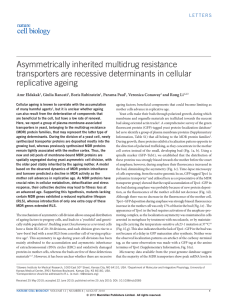Handy GFPCam - Portable Kinetic GFP Imaging Fluorometer
advertisement
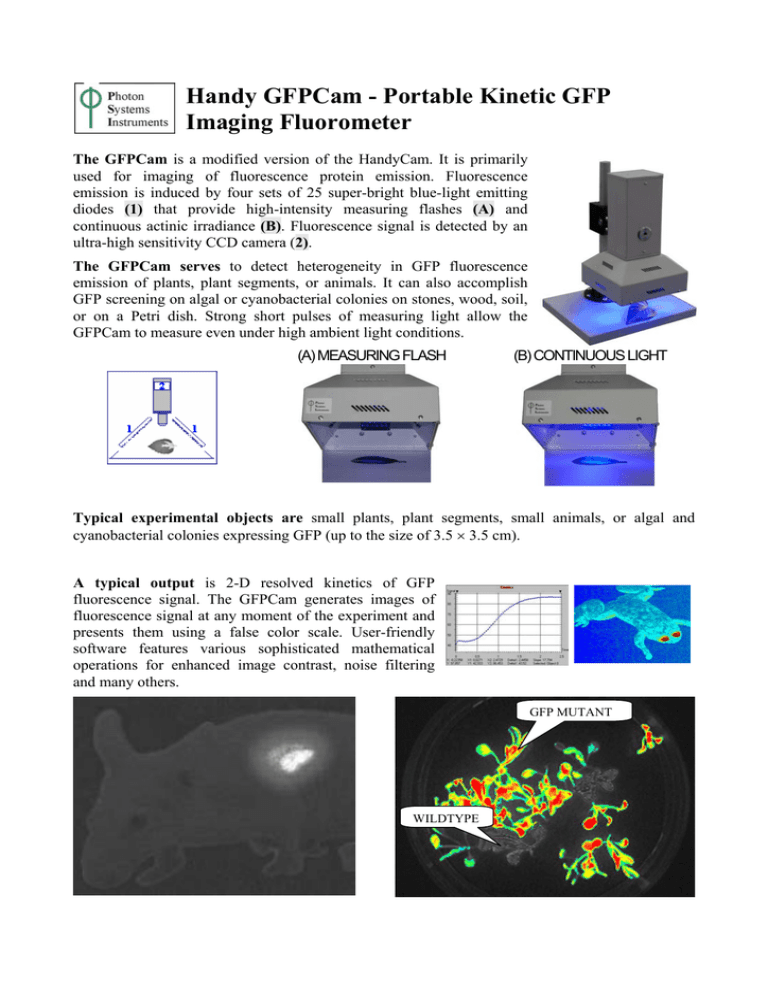
Handy GFPCam - Portable Kinetic GFP Imaging Fluorometer The GFPCam is a modified version of the HandyCam. It is primarily used for imaging of fluorescence protein emission. Fluorescence emission is induced by four sets of 25 super-bright blue-light emitting diodes (1) that provide high-intensity measuring flashes (A) and continuous actinic irradiance (B). Fluorescence signal is detected by an ultra-high sensitivity CCD camera (2). The GFPCam serves to detect heterogeneity in GFP fluorescence emission of plants, plant segments, or animals. It can also accomplish GFP screening on algal or cyanobacterial colonies on stones, wood, soil, or on a Petri dish. Strong short pulses of measuring light allow the GFPCam to measure even under high ambient light conditions. (A) MEASURING FLASH (B) CONTINUOUS LIGHT Typical experimental objects are small plants, plant segments, small animals, or algal and cyanobacterial colonies expressing GFP (up to the size of 3.5 × 3.5 cm). A typical output is 2-D resolved kinetics of GFP fluorescence signal. The GFPCam generates images of fluorescence signal at any moment of the experiment and presents them using a false color scale. User-friendly software features various sophisticated mathematical operations for enhanced image contrast, noise filtering and many others. GFP MUTANT WILDTYPE GENERAL DESCRIPTION The GFPCam is designed for kinetically resolved fluorescence imaging of small plants, leaves, animals, tissues, and algal or bacterial colonies both in the laboratory and in the field. In all applications, the camera allows measurement of two-dimensional resolved fluorescence transients induced by complex irradiance protocols. Fluorescence emission is induced by four sets of 25 super-bright blue LEDs that provide excitation flashes of a user-definable duration or a continuous actinic irradiance. The GFPCam is easily portable with sealed lead acid batteries in a convenient bag carried on the shoulder. The GFPCam software package includes a Wizard with the most frequently used experimental protocols. For an experienced professional, the instrument offers a sophisticated programming language that can be used to design novel timing and measuring sequences. The GFPCam is typically produced with 490 nm excitation and 510 nm emission filters with 490 nm super-bright LEDs. This combination is best suited for the popular EGFP. Optionally, it can be equipped with a different combination of filters and LEDs to measure other GFP alternatives, i.e., EBFP, ECFP, EYFP, DsRed. TECHNICAL SPECIFICATION The Instrument consists of an ultra-high sensitivity CCD camera, objective, and sample chamber with four integrated panels of LEDs. The measuring unit with its size of only 21.5 × 13.5 × 13.5 cm is perfectly suited for field experiments. Battery pack: The GFPCam operates from external NiMH batteries. The device is supplied with a battery recharger and a small power supply for lab experiments. Both the batteries and the power supply fit into a convenient bag. The CCD camera is equipped with a F1/1.4 objective with zoom. It captures 512 × 512 pixel images of 12-bit (or 14bit) grey scale with a maximum frequency of 50 frames per second. The images are recorded synchronously with measuring light flashes. Data transmission is facilitated via a USB 2.0 port. Light Sources: Measuring flashes and continuous actinic light are generated in four light panels, each containing 25 blue LEDs (λmax = 488 nm). Measuring flash duration is 10 µs - 250 µs. Continuous actinic light is adjustable in duration and power (up to 2,000 µmol photons m-2 s-1). Software: The instrument is controlled by the FluorCam software that is Windows 2000/XP or higher compatible. The software enables: • Designing and/or to modifying experimental protocols, i.e., the user can control timing, duration, and intensity of the light sources as well as the camera operation. • Performing intelligent image segmentation and displaying fluorescence kinetics of the selected image segments. • Subtracting background signals and averaging the images to improve the signal to noise ratio. Computing: A high-end computer with the USB 2.0 interface and the FluorCam software are included. Contact: Photon Systems Instruments, Ltd., Högrova 20, 612 00 Brno, Czech Republic; Fax: +420 541269005 http://www.psi.cz
